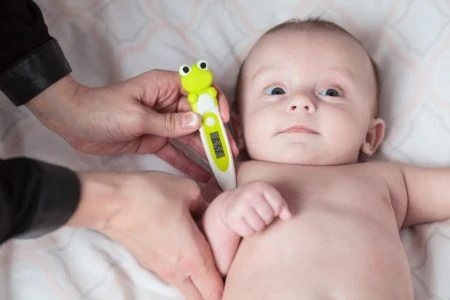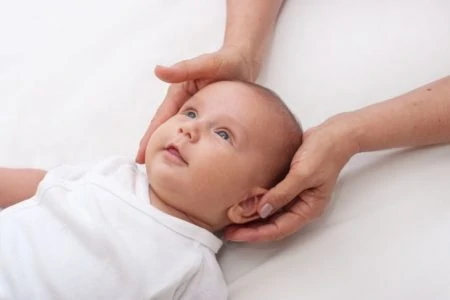Are you wanting to wear your baby but are scared by horror stories of baby hip dysplasia?
As parents, we want our babies to live perfect lives without the burden of needing surgeries or medical equipment. But some babies end up with hip dysplasia, and while it is often preventable, in some cases, it’s unavoidable.
Let’s discuss what baby hip dysplasia is, how to prevent it, and what you can do to treat it if it happens.
Key Takeaways
- Baby hip dysplasia is the underdevelopment of hip bones, making the hip joint prone to dislocation.
- Factors that increase the likelihood of hip dysplasia include genetics, in-utero position, and improper use of baby carriers, car seats, and swaddling techniques.
- To help prevent hip dysplasia, use proper carriers, swaddle with enough room for leg movement, and choose a wide car seat.
- Signs of hip dysplasia include asymmetry, limited range of motion, hip-click, and swaying back; treatment options depend on the baby’s age and severity of the condition.
What Is Baby Hip Dysplasia?
Hip dysplasia in infants is the underdevelopment of the hip bones. This can lead to hip joints that are clicky or easily dislocated. It may occur in one or both of a baby’s hips.
The hip is a ball-and-socket joint that develops while the baby is still in utero and continues to develop in early childhood. In a newborn, the hip joint mainly consists of cartilage, which is replaced by bone throughout the first year of life.
Typically, the ball grows faster than the socket, keeping the ball portion inside the socket. But with infant hip dysplasia, the socket is underdeveloped, so the ball cannot be fixed within the socket. As a result, the hip is prone to dislocation and could cause more problems in the future.
The Causes of Infant Hip Dysplasia
The exact causes of infant hip dysplasia are unknown, although it is known that a baby could either be born with the condition or develop it as an infant. However, there are a few factors that increase its likelihood.
1. Genetics
There are several genetic links to this condition. For example, if one child in a family has had infant hip dysplasia, there’s a one in 17 chance another one will have it (1). Also, if a parent had the condition as an infant, their children’s chances of having it increase to one in eight. Girls are more likely than boys to have hip dysplasia.
Its likelihood increases to a one in three chance if a parent had the condition and has already had a child with hip dysplasia.
2. Position in Utero
The way a baby sits while in utero can also affect whether they develop this problem. Some positions can cause pressure on babies’ hips, stretch the ligaments, and make them more likely to develop the condition.
The normal in-utero position puts more strain on the left hip than the right. This is thought to be why the left hip is more often affected. Breech babies, babies with torticollis, and those with foot deformities are also more likely to have hip dysplasia.
Some people also believe that hormonal changes toward the end of pregnancy which loosen a mother’s ligaments to facilitate birth, can make the baby’s ligaments lax too.
3. Baby Carriers
Baby carriers can cause a baby to develop infant hip dysplasia if they do not hold the baby’s hips in the correct position.
For example, some carriers are narrow at the crotch and allow the baby’s legs to hang down. This strains the baby’s hips and can cause dysplasia. A sling carrier can also cause hip dysplasia if you do not position your baby correctly.
4. Car Seats
Car seats can contribute to this issue because of the way they hold babies in position. A narrow car seat does not allow room for a baby’s hips to spread out (2).
5. Swaddling
Swaddling can be a great tool to comfort your baby and help them rest easy. But swaddling them too tight, until their legs have no room to spread, can increase the risk of hip dysplasia.
Preventing Infant Hip Dysplasia
While there is no way to prevent baby hip dysplasia, you can reduce the likelihood by using the proper techniques when babywearing or swaddling and using a car seat designed to prevent the condition.
- For a soft-structured carrier or mei tai, use one that is wide at the crotch and allows your baby’s hips and knees to sit in an M shape, with the knees angled slightly above the hip joints. This supports the baby’s legs from the hip to knee joints.
- When placing your baby in a sling, do not place them lying down with their legs tight together. Instead, have them sit up, with their hips spread around you, to keep them stable. These methods put less pressure on the joints and make dysplasia less likely.
- Choose a wide car seat that allows your baby’s legs to spread apart. A narrow seat prevents the legs from spreading and results in unnecessary pressure on the hip joints.
- When swaddling your baby, don’t force your baby’s legs tightly together. Instead, allow enough room for their legs to spread apart and bend slightly at the hip.
- There is no need to fear the swaddle coming undone; you can secure your baby’s arms snugly while the legs have more room. Allowing the baby’s hips to flex open will cause less strain on the joints.
- Finally, if your baby has a predisposition to this condition, either from genetics or an in-utero position, talk to your doctor to see if triple diapering would be a good idea. This method involves your baby wearing multiple diapers simultaneously to keep their hips in a frog-like position. You could also roll up cloth diapers between your baby’s legs to keep the hips at an optimal position.
Remember
What Signs Should I Watch For?
It is important to recognize the signs of hip dysplasia and catch them early. This allows treatment to begin right away so your baby can get the necessary care. Here are five things to look for.
1. Asymmetry
When you lay your baby on their stomach, do you notice that one buttock crease is higher than the other? This might be a sign of this condition. Usually, an x-ray or ultrasound can diagnose it.
2. Limited Range of Motion
Babies without hip dysplasia have flexible hip joints and their legs open up easily while diapering (3). If you notice your baby’s legs are not able to spread or relax as they should when diapering, contact your doctor.
3. Hip-Click
Hips that snap can be a regular occurrence in babies, but clicking hips can often signify infant hip dysplasia. An X-ray or ultrasound will confirm the diagnosis.
4. Pain
Babies with this condition rarely feel pain because of it. However, older children or adolescents with hip dysplasia may experience pain.
5. Swaying Back
A swaying back, exaggerated limp, or having one leg longer than the other could all be signs of hip dysplasia. An exaggerated limp would signal the condition in just one hip joint, whereas swaying back and limping together can signify both hips are affected.
Treatment
If your baby develops hip dysplasia, don’t be discouraged. Sometimes it can happen, even if you have done everything right, and no one fully understands why. Thankfully, there are several treatment options available.
Treatments might differ based on your baby’s age, activity level, or the severity of the condition. Below we will discuss treatment options based on age and how these treatments work.
Newborn to Six Months
Newborns with hip dysplasia will often need to wear braces to hold their hips in place while the joints fully develop. The Pavlik Harness is a common device, as are other abduction harnesses (4).
These devices keep the knees and hips spread apart and bent to help the hip joints develop in the optimal position (5). Usually, the baby will need to wear the braces full-time for 6 to 12 weeks, although you may remove them for bathing and diaper changes.
Once the hip joints are stable, babies will wean off the device, first wearing it part-time, then only at night, then stopping entirely.
Six to Eighteen Months
This age range is a tricky period. Sometimes, the non-surgical methods work to repair this problem, but other times, doctors may need to take more complex measures. It often depends on the doctor and how severe the dysplasia is.
The hip may be placed into the socket in a process called closed reduction while the child is under general anesthesia. General anesthesia means the child is put to sleep using gas during the procedure.
After the hip is put into place, a spica cast is used to hold it in position for several months. This procedure is called a closed reduction because you don’t have to make any incisions to set the hip.
Sometimes though, a closed reduction is not enough. In especially severe cases, doctors might recommend an open reduction instead. An open reduction is a surgery in which the hip socket is opened and tissue is removed to help the joint stay in place.
For babies under one year, doctors often prefer a medial approach, but they are likely to use an anterior approach for children over a year old (6).
This is because the thigh bone often needs to be shortened and then tilted toward the joint to relieve pressure on the hip. The procedure improves joint stability and reduces the likelihood of problems later in life.
Take Note
Eighteen Months and Older
Doctors may attempt a closed reduction for children of this age group, but the child will need to be in the cast for longer to help their hip grow back normally. Doctors might choose to perform an open reduction instead, as the process is quicker and more efficient in many cases.
The most popular treatment for this age group is an open reduction with an anterior approach and bone shortening. Ligament tightening is often done as well.
Six Years and Up
A reduction is rarely done for this age group because any bone changes are often permanent. However, you can still treat hip dysplasia, helping to delay arthritis in the future.
FAQs
Keep Moving Forward
No parent wants to face the reality that there is something wrong with their baby, but sometimes things happen despite our best efforts. Infant hip dysplasia is one of those things.
Try to do as much as you can to prevent the condition. Use a proper carrier when babywearing, keep your baby’s legs loose when swaddling, and provide a wide car seat.
But if your child still ends up with hip dysplasia, the good news is it is usually easily corrected and won’t cause lasting issues if taken care of properly.











